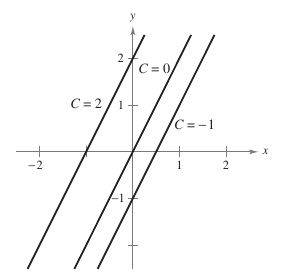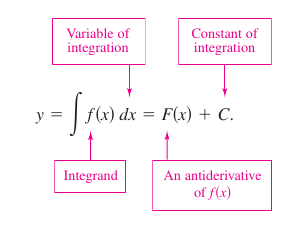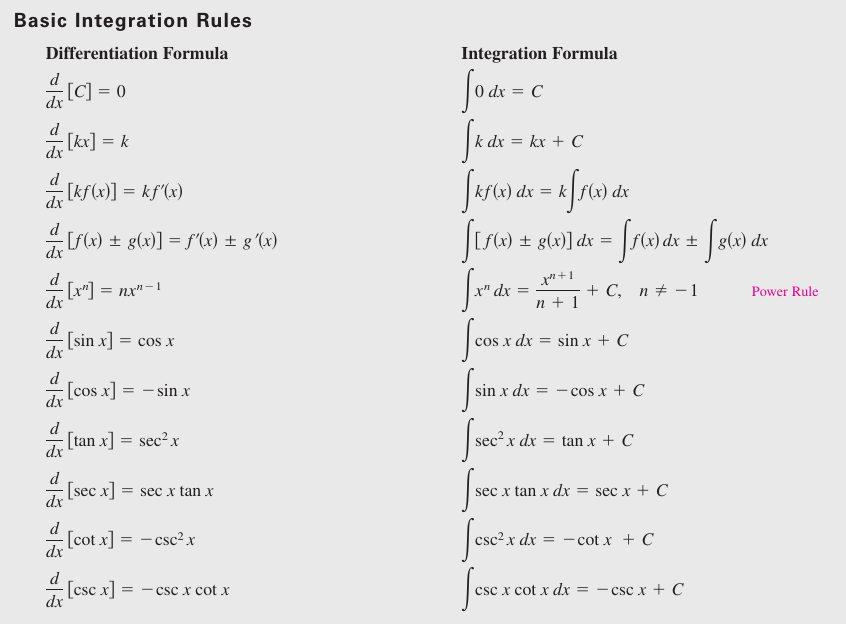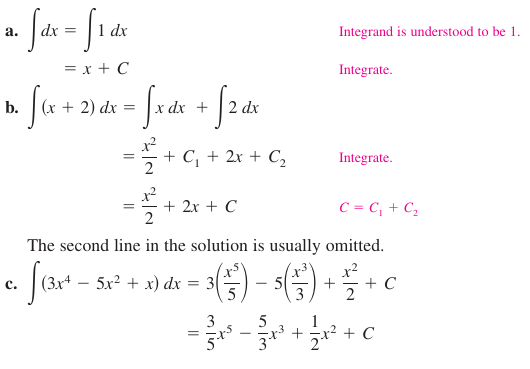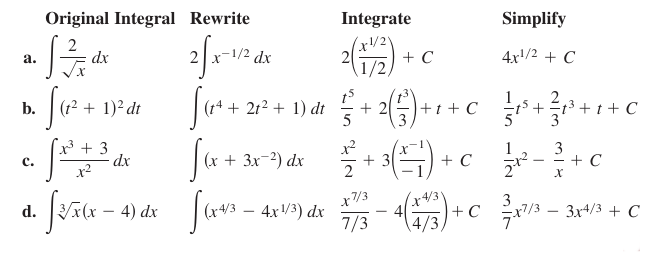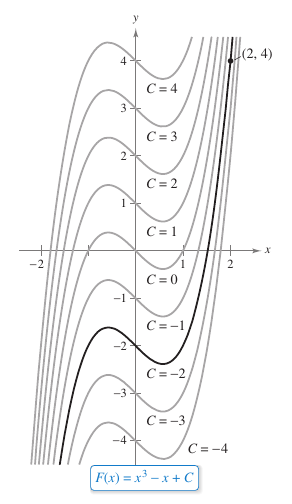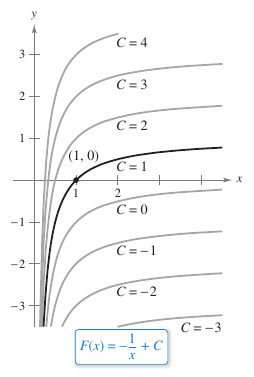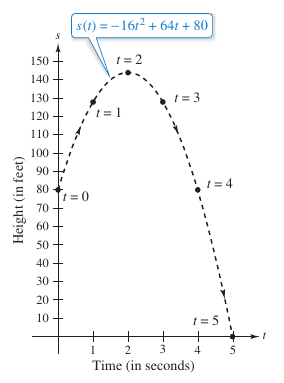Calculus I 04.01 Antiderivatives and Indefinite Integration
| Previous | Calculus I 03 Differentiation_Applications |
| Next | Calculus I 04.02 Area |
Contents
- 1 4.1 Antiderivatives and Indefinite Integration
- 1.1 Antiderivatives
- 1.2 Basic Integration Rules
- 1.2.1 Example 4.1.2 Describing Antiderivatives
- 1.2.2 Example 4.1.3 Rewrite Before Integrating
- 1.2.3 Example 4.1.4 Integrating Polynomial Functions
- 1.2.4 Example 4.1.5 Rewriting a Quotient Before Integration
- 1.2.5 Example 4.1.6 Rewriting a Trigonometric Function Before Integration
- 1.2.6 Example 4.1.7 Rewriting Before Integration
- 1.3 Initial Conditions and Particular Solutions
- 2 Internal Links
4.1 Antiderivatives and Indefinite Integration
- Learn about antiderivatives and indefinite integration.
- Find antiderivatives using basic integration rules.
Antiderivatives
To find a function \(F\) whose derivative is \(f(x)=3x^2\) use differentiation to conclude that
- $$F(x)=x^3 \text{ because } \frac{d}{dx}[x^3]=3x^2.$$
The function \(F\) is an antiderivative for \(f\).
Definition 4.1.1 Antiderivative
A function \(F\) is an antiderivative for \(f\) on an interval \(I\) when \({F}'(x)=f(x)\) for all \(x\) in \(I\).
Note that \(F\) is called an antiderivative for \(f\), rather than the antiderivative for \(f\). Observe that
- \(F_1(x)=x^3, \: F_2(x)=x^3-5, \text{ and } F_3(x)=x^3+97\)
are all antiderivatives for \(f(x)=3x^2\). For any constant \(C\), the function \(F(x)=x^3+C\) is an antiderivative is an antiderivative for \(f\).
Theorem 4.1.1 Antiderivative Representation
If \(F\) is an antiderivative for \(f\) on an interval \(I\), then \(G\) is an antiderivative for \(f\) on the interval \(I\) if and only if \(G\) is the form \(G(x)=F(x)+C\), for all \(x\) on \(I\) where \(C\) is a constant.
Proof The proof for Theorem 4.1.1 in one direction is straightforward. If \(G(x)=F(x)+C, \: {F}'(x)=f(x)\), and \(C\) is a constant, then
- $${G}'(x)=\frac{d}{dx}[F(x)+C]={F}'(x)+0=f(x).$$
To prove this theorem in the other direction, assume \(G\) is an antiderivative for \(f\). Define a function \(H\) such that
- \(H(x)=G(x)-F(x).\)
For any two points \(a\) and \(b(a<b)\) in the interval, \(H\) is continuous on \([a,b]\) and differentiable on \((a,b)\). By the Mean Value Theorem,
- $${H}'(c)=\frac{H(b)-H(a)}{b-a}.$$
for some \(c\) in \((a,b)\). However, \({H}'(c)=0\), so \(H(a)=H(b)\). Because \(a\) and \(b\) are arbitrary points in the interval, then \(H\) is a constant function \(C\). Therefore, \(G(x)-F(x)=C\) and it follows that \(G(x)=F(x)+C.\)
Theorem 4.1.1 can represent all antiderivatives for a function by adding a constant to a known antiderivative. For example, knowing that
- \(D_x[x^2]=2x\)
representing all antiderivatives for \(f(x)=2x\) by
- \(G(x)=x^2+C\) All antiderivatives for \(f(x)=2x\)
where \(C\) is a constant. The constant \(C\) is called the integration constant. The functions represented by \(G\) is the general antiderivative for \(f\), and
- \(G(x)=x^2+C\)
is the general solution for the differential equation
- \({G}'(x)=2x.\) Differential equation
A differential equation in \(x\) and \(y\) is an equation that involves \(x,\:y,\) and derivatives for \(y\). For example,
- \({y}'=3x \:\text{ and } \:{y}'=x^2+1\)
are examples for differential equations.
Example 4.1.1 Solving a Differential Equation
|
|
Find the general solution for the differential equation
Solution Find a function where the derivative is 2. One such function is
Use Theorem 4.1.1 to write the general solution for the differential equation as
The graphs for three functions in the form \(y=2x+C\) are shown in Figure 4.1.1. |
Definition 4.1.2 Indefinite Integration
When solving a differential equation with the form
- $$\frac{dy}{dx}=f(x)$$
it is easier to solve by writing in differential form
- \(dy=f(x) dx.\)
Finding all solutions to this equation is called antidifferentiation, or indefinite integration, and is denoted by the sign \(\int \). The general solution is denoted by
The expression
- $$ \int f(x) dx$$
is read as the antiderivative for \(f\) with respect to \(x\). The differential \(dx\) serves to identify \(x\) as the variable for integration. The term indefinite integral is synonymous for antiderivative. The notation
- \( \int f(x) dx= F(x)+C\)
means that \(F\) is an antiderivative for \(f\) on an interval.
Basic Integration Rules
Integration and differentiation have an inverse property verified by substituting \({F}'(x)\) for \(f(x)\) in Definition 4.1.2 to obtain
|
Integration is differentiation's inverse. |
If \( \int f(x) dx = F(x)+C\), then
|
Differentiation is integration's inverse |
These two equations produce integration formulas directly from differentiation formulas, as shown in Figure 4.1.2.
Note that the Power Rule for Integration has the restriction that \(n \ne -1\). Evaluating
- $$\int \frac{1}{x} dx$$
will be described in Chapter 5 with the natural logarithmic function.
Example 4.1.2 Describing Antiderivatives
|
$$=3 \int x dx$$ |
Constant Multiple Rule |
|
$$=3 \int x^1 dx$$ |
Rewrite \(x\) as \(x^1\). | |
|
$$=3 \left ( \frac{x^2}{x} \right ) + C$$ |
Power Rule \((n=1)\) | |
|
$$=\frac{3}{2} x^2 + C$$ |
Simplify |
The antiderivatives for \(3x\) have the form
- $$\frac{3}{2} x^2+C,$$
where \(C\) is any constant.
In Example 4.1.2, note the general procedure for integration is similar to differentiation.
Original integral \(\rightarrow\) Rewrite \(\rightarrow\) Integration \(\rightarrow\) Simplify.
When indefinite integrals are evaluated, a strictly applying the basic integration rules tends to produce complicated integration constants. For example, in Example 4.1.2, the solution could be written as
- $$\int 3x dx = 3 \int x dx =3 \left ( \frac{x^2}{2} + C \right )= \frac{3}{2} x^2 + 3C.$$
Because \(C\) represents any constant there is no need to write \(3C\). Just \(C\) will do.
Example 4.1.3 Rewrite Before Integrating
Example 4.1.4 Integrating Polynomial Functions
The basic integration rules allow integration for any polynomial function.
Example 4.1.5 Rewriting a Quotient Before Integration
|
$$=\int \left ( \frac{x}{\sqrt{x}} + \frac{1}{\sqrt{x}} \right ) dx$$ |
Rewrite as two fractions |
|
$$=\int (x^{1/2}+x^{-1/2}) dx$$ |
Rewrite with fractional exponents | |
|
$$=\frac{x^{3/2}}{3/2} + \frac{x^{1/2}}{1/2} + C$$ |
Integrate | |
|
$$=\frac{2}{3} x^{3/2}+ 2x^{1/2}+C$$ |
Simplify | |
|
$$=\frac{2}{3} \sqrt{x}(x+3) + C$$ |
The first step in integration is always rewrite the integrand in a form that fits a basic integration rule.
When integrating quotients, do not integrate the numerator and denominator separately.
This is no more valid in integration than it is in differentiation. For example, in Example 5.1.5, understand that
- $$\int \frac{x+1}{\sqrt{x}} dx = \frac{2}{3} \sqrt{x}(x+3) +C$$
is not the same as
- $$\frac{\int (x+1) dx}{\int \sqrt{x} dx}=\frac{\frac{1}{2} x^2+x+C_1}{\frac{2}{3} \sqrt{x}+C_2}.$$
Example 4.1.6 Rewriting a Trigonometric Function Before Integration
|
$$=\int \left ( \frac{1}{\cos x} \right ) \left ( \frac{\sin x }{\cos x} \right ) dx$$ |
Rewrite as a product |
|
$$=\int \sec x \tan x dx$$ |
Rewriting using trigonometric identities | |
|
\(=\sec x + C\) |
Integrate |
Example 4.1.7 Rewriting Before Integration
Note that checking the answer to an antidifferentiation problem can be done by differentiating. For example, in Example 4.1.7(a), check that \(4x^{1/2}+C\) is the correct antiderivative by differentiating the answer to obtain
|
Use differentiation to check antiderivative |
Initial Conditions and Particular Solutions
|
|
The equation
has many solution, each differing by a constant. This means the graphs for any two antiderivatives are separated by the difference between the constants. For example, the antiderivative graphs for
are shown in Figure 4.1.3. Each antiderivative is a solution for the differential equation
In many integration applications there is just enough information given to determine a particular solution. That is, the value for \(y=F(x)\) for a particular \(x\)-value. This is called an initial condition. For example, only one curve passes through the point \((2,4)\), as shown in Figure 4.1.3. To find this curve take the general solution and apply the initial condition
The result is
which implies that \(C=-2.\) Therefore the particular solution is
|
Example 4.1.8 Finding a Particular Solution
|
|
Find the general solution for
and find the particular solution that satisfies the initial condition \(F(1)=0.\)
Using the initial condition \(F(1)=0\), the solution for \(C\) is
The particular solution is
as shown in Figure 4.1.4. |
Example 4.1.9 Solving a Vertical Motion Problem
|
|
A ball is thrown upward with an initial velocity at 64 feet per second from an initial height at 80 feet.
Using -32 feet per second per second as the acceleration due to gravity, the antiderivatives are
Applying the initial velocity produces
which implies that \(C_1=64.\) Integrating produces
Plugging in the initial height produces
which implies that \(C_2=80\). The position function is
as shown in Figure 4.1.5. b. Using the position function found in part (a), the time when the ball hits the ground is \(s(t)=0.\) Because \(t\) must be positive the ball hits the ground 5 seconds after it was thrown. |
In Example 4.1.9, note the position function has the form
- $$s(t)=\frac{1}{2}gt^2+ v_0t+s_0$$
where \(g=-32\), \(v_0\) is the initial velocity, and \(s_0\) is the initial height, as presented in Section 2.2.
Example 4.1.9 shows how to use calculus to analyze vertical motion problems in which acceleration is determined by a gravitational force. Similar strategies are used to analyze other linear motion problems, vertical and horizontal, in which the acceleration, or deceleration, is acted on by another force.
Internal Links
Parent Article: Calculus I 04 Integration
